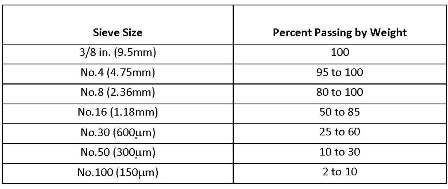
Today (NST)
Saturday, Apr 26, 2025
Smart Search
Please post in your Technical Queries, Comments & Suggestions to Contact us......
Advertisement

For Advertisement
|
|
| Subscribe to BREINS Sci-Tech |
| Visit this group |

Concrete Technology
Grading Requirements
of Fine Aggregates (ASTM C33)

The presence of free moisture content in fine aggregate particles results in “bulking”. Bulking results in an increase in the volume of a given mass of sand caused by the films of water pushing the sand particles apart.
The bulking increases with the increase in moisture content up to a certain limit and beyond that the further increase in moisture content results in the decrease in volume and at a moisture content representing saturation point, the fine aggregate shows no bulking. It has been seen that fine sand bulks more than coarse sand.
The bulking factor can be found out by filling the wet sand in a water tight measuring box up to the top and then pour water to inundate the sand. Then measure the subsidence of sand and express it as a percentage. This gives the bulking factor and the percentage of bulking so found out could be used for correcting the volume of the fine aggregate to be used.
Bulking factor can also be evaluated as :
Bulking Factor=(Volume of moist aggregate at optimum moisture)/(Volume of the dry sand)
Usually the bulking factor varies from 1.0 to 1.32 depending on the moisture content and the type of sand.
The fine aggregates obtained from natural sources is likely to contain organic impurities in the form of silt and clay. The manufactured fine aggregate does not normally contain organic materials. But it may contain excess of fine crushed stone dust. Excessive silt and clay contained in the aggregates may result in increased shrinkage or permeability in addition to poor bond characteristics. The excessive silt & clay may also necessitate greater water requirements for given workability.
To ascertain the quantity of organic impurities, a simple test known as colorimetric test is made. The sample of sand is mixed with a liquid containing 3 percent solution of sodium hydroxide in water. It is kept for 24 hours and the color developed is compared with a standard color card. If the color of the sample is darker than the standard color card, it is inferred that the content of organic impurities in the sand is more than the permissible limit. In that case either the sand is rejected or is used after washing.
The quantity of clay, fine silt and fine dust are determined by sedimentation method. In this method, a sample of aggregate is poured into a graduated measuring jar and the sample is nicely rodded to dislodge particles of clay and silt adhering to the aggregate particles. The jar with the liquid is completely shaken and then is kept in undisturbed condition during which sedimentation takes place. After a certain time interval, the thickness of the layer of clay and silt standing over the fine aggregate particles will give a fair idea of the percentage of clay and silt content in the sample of aggregate under test.